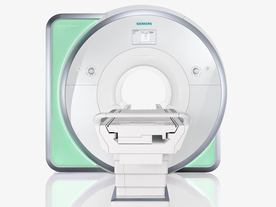 | Info
Sheets |
| | | | | | | | | | | | | | | | | | | | | | | | |
 | Out-
side |
| | | | |
|
| | | | |
Result : Searchterm 'SNR' found in 0 term [ ] and 46 definitions [ ] and 46 definitions [ ] ]
| previous 11 - 15 (of 46) nextResult Pages :  [1 2 3 4 5 6 7 8 9 10] [1 2 3 4 5 6 7 8 9 10] |  | |  | Searchterm 'SNR' was also found in the following services: | | | | |
|  |  |
| |
|
| |  | |
• View the NEWS results for 'Imaging Coil' (9).
| | | | |  Further Reading: Further Reading: | Basics:
|
|
| |
|  | |  |  |  |
| |
|

From Siemens Medical Systems;
Received FDA clearance in 2010.
The MAGNETOM Aera is a patient friendly, comfortable 1.5 Tesla MRI system with advanced radio frequency chain.
The system is equipped with the Tim 4G and Dot system (Total imaging matrix + Day optimizing throughput), to enhance both productivity and image quality.
Tim 4G technology provides improved SNR. The standard system configuration of 48 radio frequency channels and 204 coil elements creates an imaging matrix that allows maximum use of coil elements at full field of view. Dot provides improved image consistency through new features like auto align, auto FoV and automatic bolus detection.
Device Information and Specification
CLINICAL APPLICATION
Whole body
Head, spine, torso/ body coil, neurovascular, cardiac, neck, shoulder, knee, wrist, foot//ankle and multi-purpose flex coils. Peripheral vascular, breast, shoulder. Up to 60% more SNR with Tim 4G.
CHANNELS (min. / max. configuration)
48, 64
MINIMUM TE
3-D GRE: 0.22 (256 matrix), Ultra-short TE
At isocenter: L-R 70 cm, A-P (with table) 55 cm
MAGNET WEIGHT (gantry included)
3121 kg
DIMENSION H*W*D (gantry included)
145 x 231 x 219 cm
MAX. AMPLITUDE
33 or 45 mT/m
3 linear with 20 coils, 5 nonlinear 2nd-order
POWER REQUIREMENTS
380 / 400 / 420 / 440 / 460 / 480 V, 3-phase + ground; 85 kVA
| |  | | | |
|  | |  |  |  |
| |
|
| |  | |
• View the NEWS results for 'MEDIC Technique' (15).
| | | | |  Further Reading: Further Reading: | Basics:
|
|
| |
|  |  | Searchterm 'SNR' was also found in the following services: | | | | |
|  |  |
| |
|
The number of data points collected in one, two or all three directions. Normally used for the 2D in plane sampling. The display matrix may be different from the acquisition matrix, although the latter determines the resolution. Measurement time may be saved by not acquiring raw data lines corresponding to high resolution. Not measured rows are filled with zeroes prior to the image calculation. A square image is the result of an interpolation in phase encoding direction.
See also Zero Filling.

Image Guidance
| |  | |
• View the DATABASE results for 'Matrix Size' (4).
| | | | |
|  | |  |  |  |
| |
|
| |  | |
• View the DATABASE results for 'Partial Echo' (4).
| | | | |  Further Reading: Further Reading: | Basics:
|
|
| |
|  | |  |  |
|  | |
|  | | |
|
| |
 | Look
Ups |
| |